The Perfect Creation in the Taste System
We humans have to eat and drink if our bodies’ vital functions are to be maintained. That’s how we obtain the necessary energy for the trillions of cells in our bodies. In eating, we actually take decisions that will directly affect our health. We know what to eat, and what not to. We understand which foods are nutritious, which have no nutritional value, and those that may be harmful.
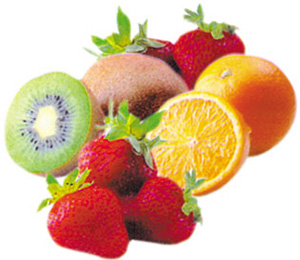 |
We throw out foods that go stale or rotten, whose tastes we immediately recognize. We can tell ripe fruit from unripe by evaluating how bitter it is. We can distinguish acidic liquids from bitter ones, and toxic substances by their bitter taste. We can easily select foods that provide us with mineral salts and fluids necessary for maintaining our bodies’ equilibrium, the amino acids used for protein synthesis in our cells, and the carbohydrates and lipids to meet our energy requirements.
Moreover, we know when to eat certain foods and when not to. When feeling fatigued, we choose ones with high levels of vitamins, minerals and sugar. When our blood pressure falls, we eat salty foods, but avoid salty foods and drinks when it rises.
The marvelous system we possess, taste, allows us to do all this. Our flavor- perception system analyses proteins, ions, complex molecules and many other compounds, and works unceasingly on our behalf for our entire lives.
 |
| But give glad tidings to those who believe and work righteousness, that their portion is Gardens, beneath which rivers flow.Every time they are fed with fruits therefrom, they say: "Why, this is what we were fed with before"... (Surat al-Baqara: 25) |
Along with meeting our daily nutritional requirements, we take great pleasure from the incomparable flavors of well-cooked meals, fruit, cakes and desserts. Try to recall all the many delicious foods and drinks you have sampled in your life: the lemonade and fruit juices to quench your thirst, the melons you ate in the heat of summer, a chop sizzling on the barbecue, chocolate ice cream, cakes, pies, pasties, puddings, rice, honey...
We perceive these delights thanks to the taste-perception mechanism placed at our service by our Almighty Lord. This chapter shall examine this matchless system in some detail and show what a superior work of Creation it is.
The Flawless Organization in the Tongue
Leaf through a cookbook; you will see thousands of recipes in it. It is estimated that there are some 20,000 edible plant species worldwide.118 The variety of solid and liquid foodstuffs is striking. Yet despite all this variety, you have no problem in distinguishing among different tastes. For example, you can immediately tell the difference between boiled and roast chicken, even with your eyes closed.
You have no difficulty in distinguishing the flavor of chicken from that of dozens of different foods. The secret of this ability lies in the organization within the tongue, your taste-perception organ.
The tongue can be compared to a laboratory carrying out complex chemical analyses, because everything we eat or drink consists of very different molecules. There are hundreds, even thousands of separate chemical substances in every plate of food you eat.119 According to taste expert David Schaeppi, the number of flavor-imparting chemical substances is 225 in a banana and 350 in a strawberry.120 The significance of this information, which you may be encountering for the first time, is that the marvelous laboratory known as the tongue analyzes countless different molecules with unerring accuracy. (Figure 23) So what kind of design does this talented tongue of yours possess?
There are a large number of nerve fibers in the tongue, a design that makes it possible to move in all directions with ease. In fact, the tongue is four times more mobile than our fingers,121 and assumes important functions in talking, chewing and swallowing. Foods placed in the mouth are moistened and softened by saliva released by the salivary glands, before being transmitted to the esophagus. It is at this in-between point that the tongue’s taste receptors are in their active state. In order to understand their activity, we must first be acquainted with the set-up within the tongue.
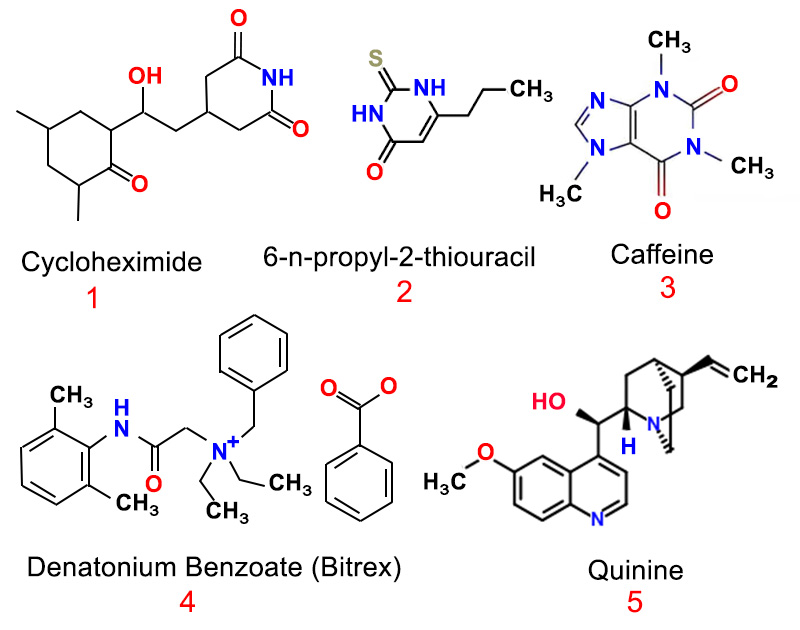 | |
| 1. Cycloheximide | 4. Denatonium Benzoate (Bitrex) |
| (Figure 23) The substances here leave a bitter taste in the mouth. As we can see, the chemical structures of these few substances are very different from one another. Thanks to the perfect creation and extraordinary capacity of the taste-perception system, we are able to perceive countless taste molecules. | |
Taste-receptor cells are specialized cells found only in the tongue and in certain regions of the mouth. The taste-perceiving cells in the tongue are collected in bulb-like structures known as taste buds—structures known as papillae. These tiny protrusions that give the tongue its familiar rough appearance are found on the tongue’s upper surface and sides. There are four kinds of papillae, distributed among various regions. (Figure 24) The most striking of these are the fungi form papillae at the front of the tongue, which become more clearly visible after one has drunk milk. The vallate papillae, larger and fewer in number than the others, are set out in a reverse V shape at the back of the tongue. Foliate papillae are found on the rear sides of the tongue. Fungiform, vallate and foliate papillae contain taste buds. Filiform papillae, the most numerous type, do not contain taste buds, and cover almost the entire surface of the tongue. These are concerned with the sense of touch.
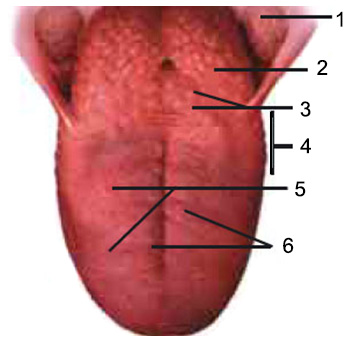 | 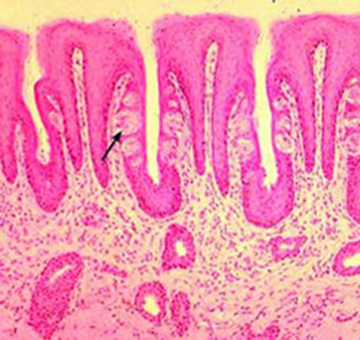 | |
| 1. Palatine Tonsil | 4. Foliate Papillae | Left: (Figure 24) The positions of the papillae on the human tongue |
When the tongue is examined under a powerful microscope, the first thing one notices is a structural regularity. From smallest to largest, the order runs: taste cell, taste bud, papilla. There are around 10,000 taste buds in the tongue.122 (Figure 25) Vallate papillae contain between 700 and 3,000 taste buds, and foliate papillae from 320 to 2,950. There are around 3 to 10 taste buds in each fungiform papilla.123 The number of taste cells in every taste bud varies between 50 and 100.124
These figures are significant in demonstrating the balance in creation. If the number of taste cells and taste buds is below normal, then one's sense of taste will decline, and even disappear. But if the number is greater than normal, then familiar flavors will seem excessively sweet or bitter. Clearly, each cell needs to be present in exactly the right number, or eating and drinking would be unpleasant, even uncomfortable.
As you know, the smaller an electronic device, the more successful its design is considered to be. That’s why engineers try to the greatest possible use of a small space. Looking at the organization in the taste buds, examples of this design principle are immediately apparent. Some 100 taste cells are set out in the taste bud in an ideal manner (Figure 26-27).
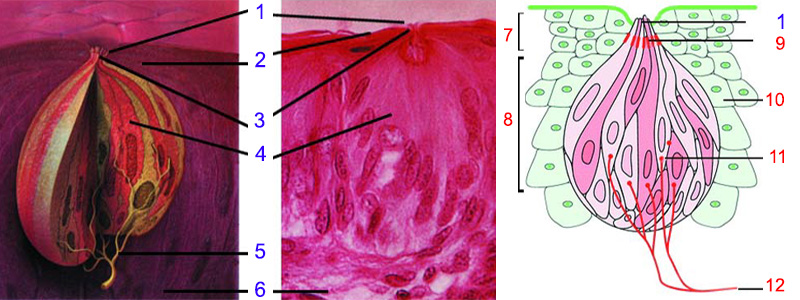 | |
| 1. Taste Bud | 7. Upper Part |
| Left: (Figure 26) The organization in a taste bud. Right: (Figure 27) In a single taste bud, some 100 taste preceptor cells combine in a flawless design. The top part of the taste bud is divided from the body by a special system. This means that the taste molecules communicate with the taste micro-hairs on the top of the taste bud and do not pass on to the main body. | |
In addition, the buds also contain a number of basal cells and secretion cells, the taste cells' production center. When we examine the structures in the papillae, we encounter a similar situation. (Figure 28-29) In the cleft around the papilla, the taste cells arranged along the edges of the papillae establish communication with taste molecules. Thanks to this structure, the widest possible surface for communication is established in a very small area.
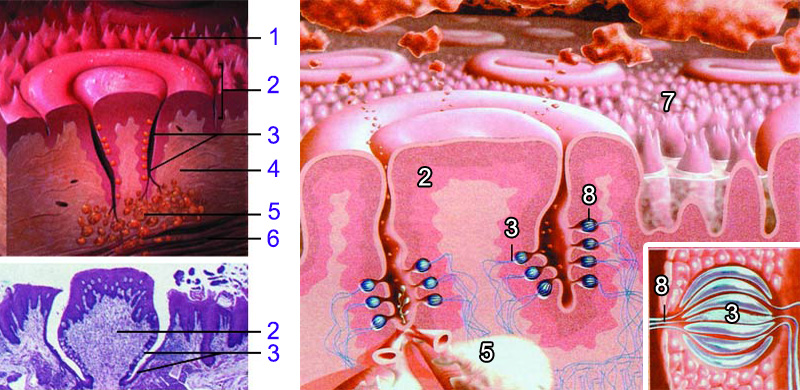 | |
| 1. Filiform Papillae | 5. Saliva Glands |
| Left: (Figure 28) The organization in a circumvallate papilla | Right: (Figure 29) Details of the structure in circumvallate papillae |
That these cells are present in just the right number and form reveals evidence of a very superior Creation. Another extraordinary property is that they are located in exactly the right place.125 If just one of these many details in the taste-perception system were to change—if the taste cells were beneath the tongue instead of on top and to the sides of it, then clearly, the sense of taste would largely disappear, and life would become difficult. The fact that every detail in the system is exactly right reminds people of reason and common sense that God has created all things flawlessly, within a perfect order.
There can be no organization without an organizer, and no arrangement without an arranger. When you look around you, everything you see—tables, chairs, lamp, curtain, window, television, computer—is a product of Man’s creation. The taste system, many times more complex than these, is also the product of a Creation that belongs to God, the Lord of the worlds.
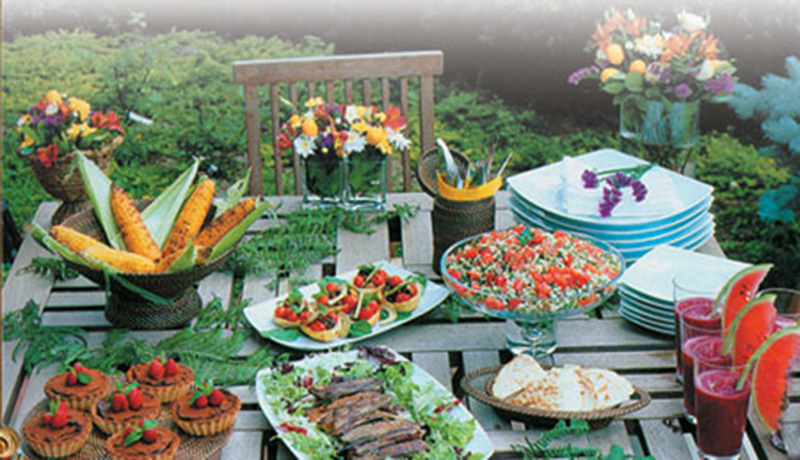 |
Basic Tastes
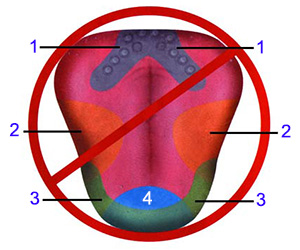 | |
| 1. Bitter | 3. Salty |
| (Figure 30) Latest scientific research has revealed the error of the so-called taste map and the existence of an exceptionally complex communications system in every taste cell. | |
The prevailing scientific view is that there are five basic tastes: sweet, salty, bitter, sour and umami.126 Everyone is familiar with the first four, though the fifth may be a new concept to some. Umami is a taste stemming from glutamate, one of the 20 amino acids in the structure of proteins, which is found in meat, fish and leguminous plants. (Monosodium glutamate, used to enhance flavor in ready-to-eat meals, also imparts this flavor.)
Some scientists do not agree that the foods we eat and drink consists of combinations of only these five tastes. Some researchers, such as Professor Andrew L. Spielman (New York University, College of Dentistry), Professor Joseph G. Brand (Monell Chemical Senses Center), and Dr. Wentao Yan (New York University, College of Dentistry), think that other tastes, such as fat, water and metallic tastes, may constitute fundamental flavors.127
One piece of information that research brought to light is that the taste map is incorrect.128 (Figure 30) The taste map was originally based on the assumption that sweetness was perceived at the tip of the tongue, saltiness on the edges, sourness on the sides and bitterness at the back. But this map resulted from a misinterpretation of 19th-century research. The latest research shows that taste cells react to more than one stimulant,129 and that each taste receptor has a more complex communication system than had been thought. Contrary to previous belief, every taste cell establishes communication with several specific stimuli, not just one. The methods of communication in receptor cells are one of the proofs that these cells are the work of Creation.
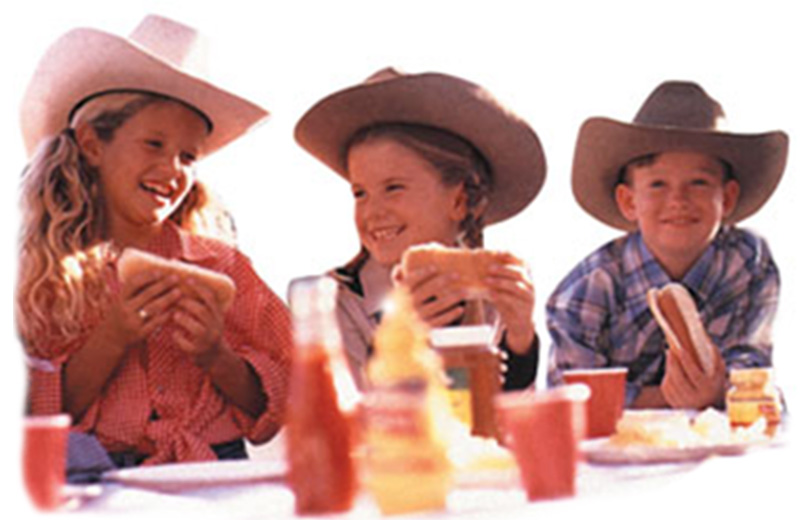 |
| The taste perception system is an exceedingly complex design that exhibits the sublimity of God's creation. |
Complex Communication Systems
 |
| We sent down a measured amount of water from heaven and lodged it firmly in the Earth; and We are well able to remove it. By means of it We produce gardens of dates and grapes for you, in which there are many fruits for you and from which you eat. (Surat al-Muminun: 18-19) |
Professor Joseph Brand is a scientist known for his work on the sense of taste. According to him, it takes only 0.2 to 0.5 seconds for us to perceive the taste of anything placed on the tongue.130 What takes place during this interval—shorter than the time it takes you to open and close your eyes has been the subject of investigation for many years. Presently, the main lines of the processes involved in taste perception have been established.131
Taste begins when compounds from the food you chew are dissolved in saliva. We detect the taste of salty foods more quickly because salt dissolves faster in saliva than do other substances. Indeed, the salivary glands sometimes start working when the smell of food is detected—in the so-called Pavlovian response—preparing the tongue for tasting. Like every detail in taste perception, this stage is important too. Were it not for this secretion, you would be unable to taste dried foods. (Saliva also contains proteins and enzymes that assist the digestive and immune systems. Research into saliva’s features and functions is ongoing, but studies have already revealed that this fluid, generally regarded as insignificant, has a rather complex structure.)
 |
| Taste cells have more than one mode of communication. Thanks to this feature of the cells, we are able to detect such different tastes as sweet, bitter, sour and salty. |
The molecules from food communicate with the taste receptors on the tongue via hair-like structures known as microvilli on the cell’s tip. These microvilli, or micro-hairs emerge into the mucus membrane coating the tongue through tiny apertures known as taste pores. Taste-cell receptors are located on the micro-hairs. The average diameter of a taste pore is four-thousandths of a millimeter, or 0.000157 of an inch. 132
Taste compounds are also communication molecules, transmitting the messages they carry to the ion channels or receptors on the cell membrane. The events taking place at this stage at the cellular and molecular level are, as stated by Professor Stephen Roper of Miami University, still the subject of investigation.133 There are many different methods of communication, corresponding to many different taste compounds. In other words, different communication networks are established for different tastes such as sweet, bitter and salty. Taste cells have more than one way of communicating, and only the general lines of some of them are understood as yet.
Another surprising factor is the significant differences in taste perception mechanisms between species.134 These phenomena call for long reflection: Naturally, molecules and cells devoid of consciousness cannot by themselves develop wholly different means of communication; these communication systems are signs of the omniscience of our Lord, Who created them.
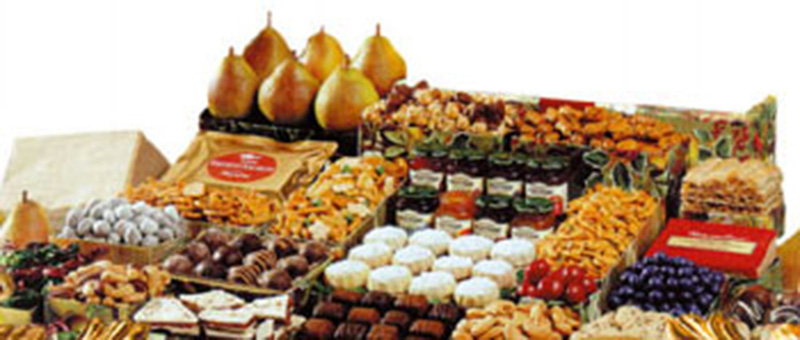 |
| God is He Who splits the seed and kernel. He brings forth the living from the dead, and produces the dead out of the living. That is God, so how are you perverted?(Surat al-An'am: 95) |
Those taste molecules that carry the news of saltiness and sourness establish direct links with the ion channels in the cell membrane. Sweet, bitter and umami molecules, on the other hand, attach to receptors in the cell membrane. The well known researchers David V. Smith (of the University of Tennessee Health Science Center) and Robert F. Margolskee (of the Mount Sinai School of Medicine) compare the link between molecule and receptor to that of a lock and key, as is the case with scent perception.135 In the same way that a specific key opens a specific lock, a specific molecule sets each receptor into action. On the cell membrane, which consists of fat and proteins and is just 1/100,000th of a millimeter (0.000000394 of an inch) thick, are channels that regulate entry and exit to the cell and receptors that function like switchboards. These astonishing marvels recognize millions of different taste molecules without error, each and every time, and flawlessly carry out their various functions.
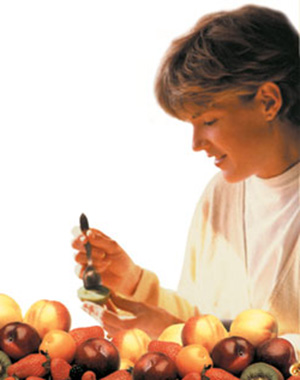 |
| Taste molecules establish bonds with the ion channels on the taste-cell membranes in order for us to detect the bitter flavor of a kiwi fruit. |
We pointed out that there are around 1,000 different receptors in scent perception, but the number of different receptors in taste perception is unknown. Last years, various researchers first discovered the T2R/TRB receptors. 136 Professor Linda Buck states that this discovery is only the beginning of a likely long process of research into taste. 137 The researcher Professor Charles S. Zuker states that it is impossible to estimate how many different taste receptors will emerge before the research is completed.138 Even with 21st -century technology, a large part of the structures in taste-cell receptors remain a mystery. This once again shows that the structures in question are the product of a superior Creation.
When the receptors are stimulated, a series of complex processes is initiated within the taste cell. During these stages, a great many proteins and enzymes fulfill their functions to the letter. For instance, when a sugar or artificial sweetener molecule attaches to a receptor, the protein complex known as gustducin goes into action. Particles separating from this complex activate a special enzyme. The enzyme in question transforms certain proteins inside the cell into second messengers. These messengers, in return, send the command for the potassium channels in the cell membrane to close. At the same time, the sodium and calcium channels are opened, and positively-charged ions begin entering the cell. In this way, the cell’s initial negative charge is eliminated, and the cell enters a neutral state. As a result of certain complex processes still not fully understood, the cell begins emitting chemical messengers known as neurotransmitters. These chemicals carry messages to the neurons around them. It is still not known for sure which neurotransmitters carry messages between the taste cell and the neuron. However, it is thought that chemical messengers such as serotonin, GABA, acetylcholine and adrenalin play a role in the taste-perception system.139
Figure 31 shows the events that take place in taste cells, depending on various stimuli. In examining these, bear in mind the following two points: First, the changes that take place in the taste cell in response to different stimuli are shown with different drawings of cells, to assist your comprehension. In fact, as we have already discussed, taste cells enter into reactions not with one, but with more than one stimulant. The second point is that only the main lines of the communication in the taste cell are shown here.
As you know, engineers produce detailed technical drawings showing the working systems of mechanical or electronic devices—clear evidence that the devices were designed by engineers, technicians or experts. No rational person can imagine that a device which he has seen in a blueprint came into being spontaneously. Now look at the taste cell communication mechanisms in Figure 31. Can you imagine that these came into being without being designed? Of course not! No rational, logical person can be taken in by such an idea.
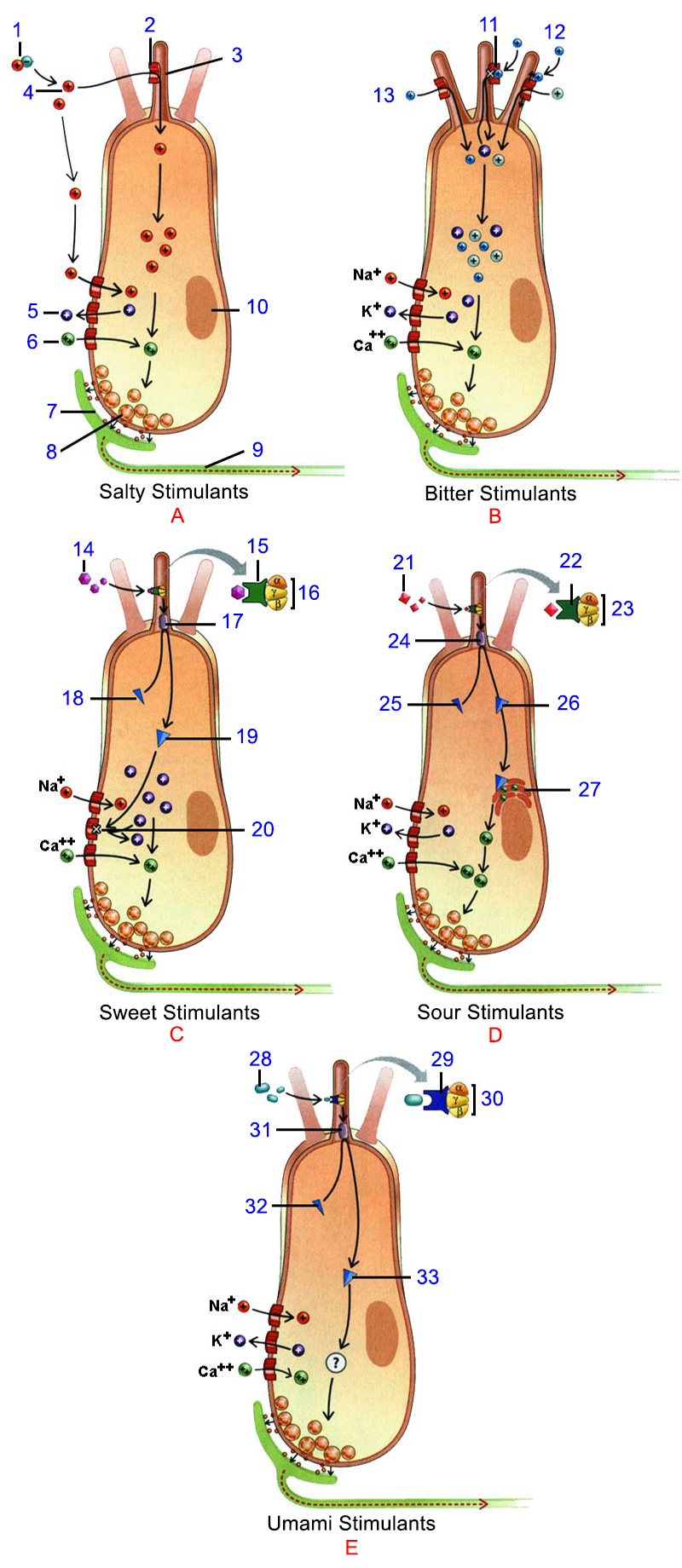 | |||
| A. Salty Stimulants 1. Salt (NaCl) | B. Bitter Stimulants C. Sweet Stimulants | D. Sour Stimulants | E. Umami Stimulants |
| (Figure 31) The main lines of the communications in the taste cell, according to various stimulants. Salty and sour stimulants establish communications with ion channels in the taste cell membrane, and sweet, bitter and umami stimulants with special receptors on the cell membrane. | |||
The theory of evolution maintains a similarly irrational claim. It is crystal-clear that the taste cell’s advanced methods of communication cannot be the work of chance or coincidence. Every stage of the system contains the most delicate and detailed calculations and arrangements that occur in a small fraction of a second. Any one of these stages is sufficient to show the existence of God, its Creator. The way evolutionists persist in their denial in the face of all the obvious evidence can be explained by their inability to rid themselves of their irrational, illogical obsessions.
The Sense of Taste in the Brain
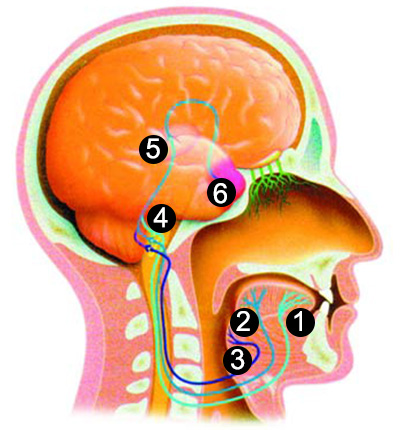 |
| (Figure 32) The Chorda tympani (1), glossopharyngeal (2) and vagus (3) nerves combine in the spinal bulb (4), from whence they carry messages to the relevant sections of the brain (5)–(6). |
The nerves in your body work far more perfectly than the postal system of a developed country. Every day since you were born, and even every moment, they have carried information to exactly the right addresses with an extraordinary success, never losing any information. In your brain there are around 100 billion nerve cells.140 When you eat or drink anything, three nerves related to taste carry the message they receive from your taste cells to the relevant addresses from among those 100 billion. In addition, they do this impeccably, for so long as you live.
The diameter of these nerves is less than 0.004 of a millimeter (0.000157 of an inch).141 Taste messages are transmitted to the brain by the chorda tympani nerve from the front two-thirds of the tongue, and from the rear third by the glossopharyngeal nerve. The vagus nerve transmits to the brain the taste signals it receives from the back of the mouth.142 (Figure 32) These three nerves send the reports from tens of thousands of taste cells to the region known as the brain stalk. From there, taste data go to the cortex, hypothalamus and amygdala regions of the brain. When you snack on a cracker, these three nerves are constantly occupied with transmitting reports to the relevant regions of the brain. In addition to these, a special nerve (known as cranial nerve V) also carries data from the cells concerning temperature, touch, pressure and pain to the brain.
How, though, do these messages turn into perceptions such as a delicious chestnut cake or a flavorful mushroom soup? How do we tell whether what we eat is fresh or stale? How do we instantly recognize foods? How is it that we analyze them in such a way as to describe their details?
In order to provide a satisfactory answer to these questions, we need to await the findings of new research. It is still not known how nerve messages turns into taste perceptions in the brain; the encoding system in the taste-perception system and the mechanism by which the brain decodes this are still not clear. What is known is that taste distinction does not stem from any particular cell model, and that the data from the taste cells constitute taste perception by being analyzed collectively in the brain.143
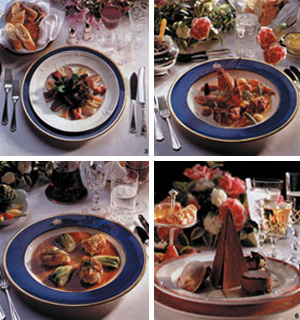 |
| When you eat or drink something, your taste nerves transmit the message you receive from the taste cells to the brain, and this information is rapidly interpreted as "a delicious chocolate cake" or "a tasty mushroom soup." |
Very probably we shall obtain more information about the workings of the taste perception system in the years to come. However, you may be sure that every new scientific discovery about the taste system will once again reveal the fact of Creation. That is because it is God, the Lord of the worlds, Who created and imparted as a blessing for living things the countless plants, fruits and vegetables, with their delightful smells and matchless flavors. This is revealed in several verses, and we are advised to reflect on and learn from this. Some of these verses read as follows:
Say: "Who provides for you from the heavens and Earth?" Say: "God. It is certain that one or the other of us, either we or you, is following guidance or else clearly astray." (Surah Saba': 24)
It is He Who sends down water from the sky from which We bring forth growth of every kind, and from that We bring forth the green shoots and from them We bring forth close-packed seeds, and from the spathes of the date palm date clusters hanging down, and gardens of grapes and olives and pomegranates, both similar and dissimilar. Look at their fruits as they bear fruit and ripen. There are Signs in that for people who believe. (Surat al-An'am: 99)
O humanity! Remember God's blessing to you. Is there any creator other than God providing for you from heaven and Earth? There is no god but Him. So how have you been perverted? (Surah Fatir: 3)
The Changing of the Guard in the Taste Cells
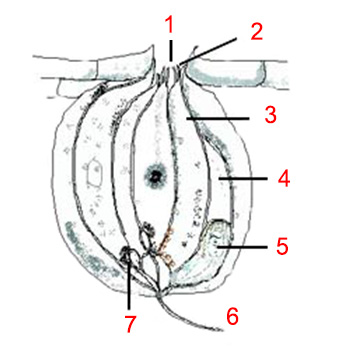 | |
| 1. Taste Bud | 5. Basal Cell |
| (Figure 33) The position of basal cells in the taste bud, where new taste cells develop | |
As you know, every piece of apparatus has a finite working life. The harder and heavier the conditions under which a device operates, the shorter its lifespan will be. The same applies to the taste cells in the tongue. Every day, they come into contact with foodstuffs considerably above or below body temperature, and with acidic foods, which present them with difficult, even extreme conditions.
For example, a hot cup of tea, an iced fruit juice, strong coffee or bitter grapefruit juice all wears them down to a degree. One would naturally expect the taste cells to gradually lose their perception capabilities and for the sense of taste to be lost. Yet such a thing does not happen. Why, then, does your sense of taste not fade and die?
The reason is the taste cells’ renewal mechanism. On average, they change every 10 days.144 In other words, the taste cells you have now are entirely different from those you had 10 days ago. Basal cells in the taste bud mature and replace the old cells within a few hours. (Figure 33)
These processes, of which you are utterly unaware, take place so quickly that the taste cells you use at dinner are different from those you had at breakfast.145 Thanks to this perfect mechanism, your taste cells are always reliable and healthy. You continue to perceive familiar flavors and to identify substances that could harm your health.
Have a look around you. Can any of the high-tech devices you see renew themselves? Of course not! Bearing this in mind, you can better appreciate the superb creation in the sense of taste. At the same time, this truth is a means whereby we can once more be reminded of the infinite generosity and bounteousness of our Lord.
Although the great majority of people are well aware of this, still they persist in ingratitude and refusal to give thanks. At every moment, they witness the ever more stupendous proofs of creation in their own bodies, yet heedlessly turn their backs on them.
The situation of such people is described in Surat an-Naml:
God shows favor to humanity but most of them are not thankful. (Surat an-Naml: 73)
The Situation Facing Evolutionists
 |
Pro-evolution researchers and writers share one feature in common, traces of which can easily be seen in their speeches, articles and books. They are blindly devoted to the theory of evolution. Although they have absolutely no evidence with which to back it up, they refuse to abandon their fixed ideas. Instead of admitting their errors, they become even more determined and continue to raise new speculations.
Consider the sense of taste, one of this book’s main subjects. Evolutionist researchers claim that the sense of taste evolved in order to identify high-calorie foods and poisonous foodstuffs.146 According to this claim, the first living things, having to eat in order to survive, found ways to use the resources around them by trial and error, until they could differentiate between what was useful and what was poisonous. As a result of these endeavors, their tongues acquired structures that began perceiving tastes to tell these apart. The tongue gradually began distinguishing flavors as well, and the sense of taste became a source of delightful sensations, not just of meeting nutritional needs.
But actually, this account explains nothing. We already know that our sense of taste serves to distinguish flavors from one another. Ascribing this to a process of evolution is deceptive and lacks any scientific foundation. In addition, no matter how the system in question it may have emerged, evolutionists really have to explain how it allegedly evolved. In this imaginary scenario, it is unclear how any species managed to survive until it became able to recognize poisons. No explanation is offered of how acquired experience or the alleged changes were handed on to subsequent generations. There is no need even to touch on the question of the properties possessed by the tongue, the perception systems and their mechanisms, because one cannot find the slightest explanation of their evolution in any Darwinist reference.
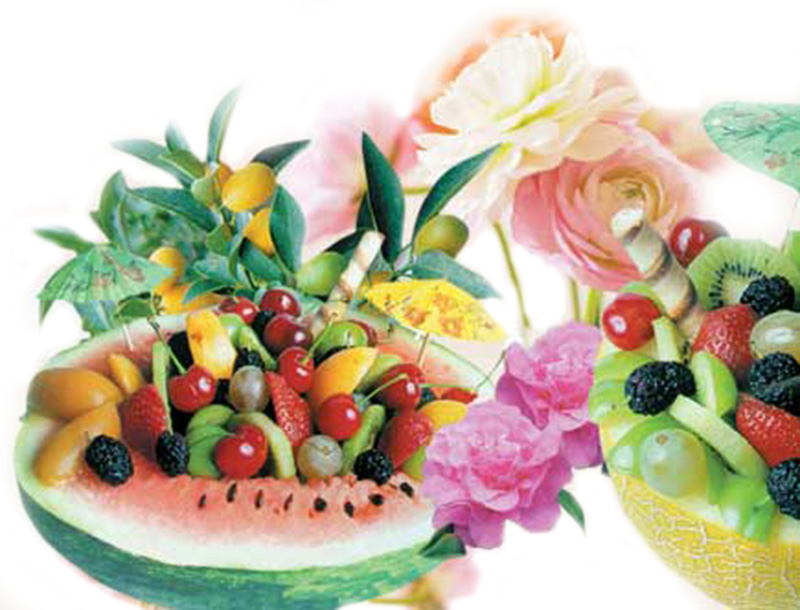 |
The above fantasy is important in terms of revealing the methods that Darwinists employ in seeking to account for such a complex mechanism. Evolutionists generally resort to one of two tactics: Some prefer not to mention such matters at all, while others shelter behind clichés of the sort given above, and are careful to add these accounts to scientific findings.
An example of this is the expressions employed by Diane Ackerman, author of A Natural History of Senses, in claiming that we are indebted to the oceans for our sense of taste.147 It is clear that her claim, for which she gives no scientific explanation, consists of merely glossing over the facts. Whenever evolutionists are pressed, they cling to the myth of the “oceans on the primordial Earth” as their savior. In fact, Ackerman is troubled by her inability to back up what she writes, and expresses the following wish:
Should an alien civilization ever contact us, the greatest gift they could give us would be a set of home movies: Films of our species at each stage in our evolution.148
 |
We have to admit that to date, evolutionists have not found any evidence to confirm a single one of their claims. And in any case, it is impossible for them ever to do so.
Therefore, Darwinists encounter the same difficulties with the sense of taste as they do in the sense of smell. That is because accounting for the sense of taste—whose details have still not been explicated with modern-day technology—in terms of coincidences is merely demeaning to the person making that claim. From the code-receptor mechanism in the brain to the wide variety of its receptors, the sense of taste is so complex that every component is clearly the product of a special design. Furthermore, the taste system’s ideal structure, the perfect and flawless way it functions, are plain for everyone to see. Bearing these facts in mind, it’s not hard to understand that there can be no random and uncontrolled intervention at work here. No random phenomenon can give unconscious molecules the ability to perceive what is eaten or smelled. No coincidence can create a harmonious geometric design for molecules that remain unaware of one another. It cannot make the harmony among them significant, in the way that a cake or an orange is. No coincidence can assume that information from molecules reaching the tongue needs to be transmitted directly to the brain.
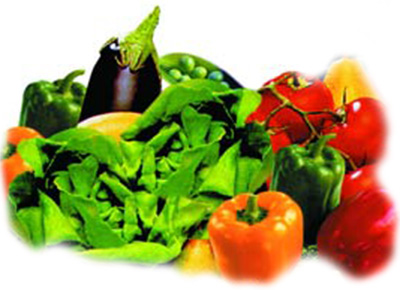 |
| No coincidence can give rise to the tongue, with its flawless creation, taste molecules ideally adapted to the structure of the tongue, or the taste cells. Like all the other senses, the sense of taste is one of God’s miracles. |
Remember that chance suggests random developments taking place within an established order, like letters being distributed randomly throughout a meaningful text. These “extra” letters cannot possibly make that text more meaningful or give it any new meaning. On the contrary, they will have a confusing effect on the text as a whole. Evolutionists’ claims regarding chance are no different, and they themselves are well aware of this.
In addition, as stated earlier, the sense of smell plays an important role in the sense of taste. Since the olfactory and taste systems are interconnected, the sense of taste means little in the absence of the sense of smell. This interrelationship no doubt causes evolutionists grave concern. Mutually dependent systems and structures displaying the irreducible complexity already referred to, reveal the impossibility of any gradual process of evolution. The fact that taste survives only with the sense of smell makes it impossible—according to the theory of evolution—for the two to have evolved independently of each another. But according to evolution, every organ, and even every feature possessed by these organs, must have had a sequential development lasting millions of years.
But if so, then taste perception must have stood by, functionless, until the development of the sense of smell—something the mechanisms of evolution itself would make impossible. According to the theory of natural selection, any structure with no function will atrophy, become vestigial, and eventually disappear.
All this means that even while evolutionists cannot explain how the extraordinarily complex taste perception evolved, they also face a major problem in accounting for how it evolved in cooperation with the sense of smell. How did two different systems, each of which permits the perception of chemical substances, evolve? The evolutionists have no answer to give.
 |
Anyone possessed of conscience and consciousness will clearly see that for the way that the brain, tongue, taste nerves, papillae, taste buds, taste cells, taste receptors, various different proteins and enzymes came together in such complete harmony, there is only one explanation. It is God, the Lord of the worlds, Who created the sense of taste and placed it at our service. The situation of those who turn to the paths of superstition by ignoring God’s flawless creation is described in the Qur’an:
God has given you wives from among yourselves, and given you children and grandchildren from your wives, and provided good things for you. So why do they believe in falsehood and reject the blessings of God, and worship, instead of God, things that have no control over their provision from the heavens or Earth in any way, and are themselves completely impotent? Do not try to make metaphors for God. God knows and you do not know. (Surat an-Nahl: 72-74)
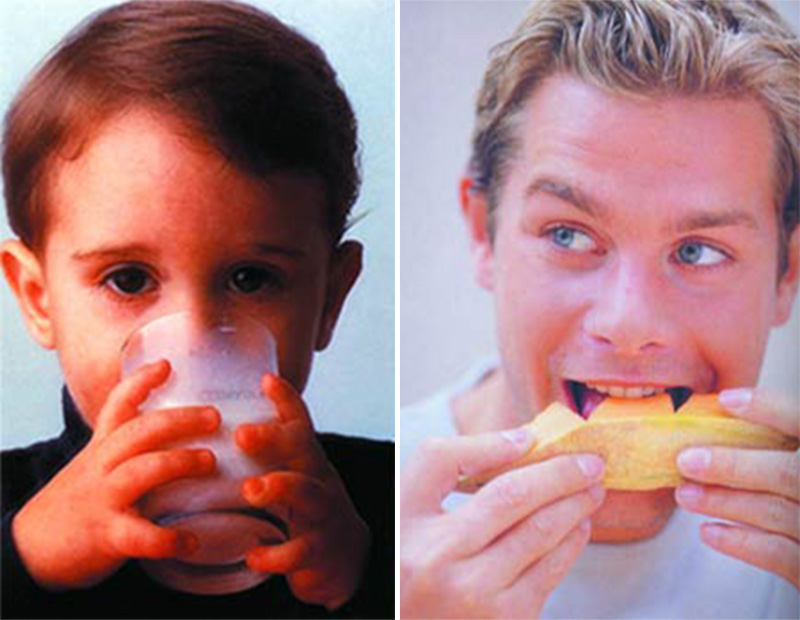 |
| The sense of taste is a blessing bestowed on human beings by God, and a manifestation of His compassion. |
The Electronic Tongue
The dazzling structures in the tongue have inspired a number of scientists. Devices that imitate the functions of the human tongue, known as electronic tongues, are still at the developmental stage. These devices are being developed to be able to distinguish fresh foods from stale and to identify decay caused by bacteria. The electronic tongue is an electronic circuit with up to 100 tiny holes, each of them designed as an artificial taste bud. Any liquid dropped onto the circuit is absorbed by the holes, like a sponge. Then, the artificial taste buds change color according to the chemical composition of the liquid, and the results appear on a screen. For example, a liquid that tests pink is sweet, and a light yellow one is slightly sour.
Eric V. Anslyn, one of the researchers into the electronic tongue, states that its design can identify up to 100 different flavors.149 That’s the current state-of-the-art, at which research and development projects performed for years by a great many scientists and engineers with large budgets have arrived. Compared with the human tongue, the artificial tongue’s capacity and quality is exceedingly primitive. Moreover, the sense of taste has been functioning to perfection ever since the creation of Man.
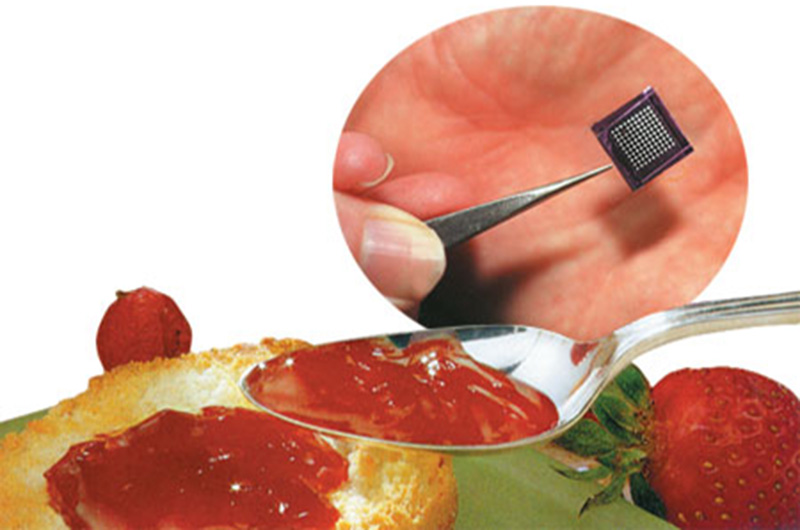 |
| The sensors used in the electronic tongue. No matter how small these sensors seem, they are very large compared to the receptors in the taste cells. |
The difference is of course plain to see. The electronic version is the product of design, planning and engineering. If all the components of this device were set placed on a table, and if one waited for even billions of years, it would still be impossible for an electronic tongue to come into being by chance. It makes no difference whether the components are left in the sea, on the slopes of a volcano, or even in space. The result will be exactly the same. Nor could the human tongue and taste perception system, so incomparably superior to the electronic tongue, have come into being as the result of consecutive coincidences. It is a waste of time to look for any other explanation than Creation. Evolutionists must either accept this, or else admit their dogmatic devotion to the theory of evolution.
What Tastes and Taste Perception Suggest
You began becoming acquainted with tastes while still an embryo in your mother’s womb. Your sense of taste began working immediately after you were born.150 The first food you tasted was your mother’s milk, which met all your needs. Thanks to the system you still possess, you consumed the necessary nutrients for growth, and avoided eating things that would have harmed you. During childhood, your sense of taste was stronger than in adulthood—which represents an important security mechanism. (Children have more taste cells than adults, and these are present in children’s upper palate, cheeks and throat, as well as in the tongue.)151 In short, your sense of taste was a great help in enabling you to distinguish between unfamiliar nutritious and harmful substances.
Your sense of taste was also at your service throughout your adolescence. It never broke down, but unfailingly identified everything you ate and drank. With its sensitivity, you analyzed substances that might be harmful or poisonous the moment you put them in your mouth. (Bitter is the taste with the lowest perception threshold among the tastes.)152 Taste buds can detect sweetness in something even if only one part in 200 is sweet. They can detect saltiness in one part in 400, sourness in one part in 130,000 but bitterness in as little as one part in 2 million.153 This ability helped you immediately spit out any potentially poisonous substances, rather than swallowing them.
 |
| To Him belongs every being that is in the heavens and on earth: all are devoutly obedient to Him. (Surat ar-Rum: 26) |
Were it not for your sense of taste, you would have had to live in a chemical laboratory and carry an analysis kit around with you in order to survive. You would have had to run tests in order to determine whether the small, white particles in a jar in your cupboard were salt, sugar, or washing powder—a poisonous substance. Even if you spent all your time analyzing the food and drink you needed, that still would not be sufficient.
Were it not for your sense of taste you might not even think of eating at all. This process, which you have to perform two or three times every day, would become a terrible burden. If you ignored it, symptoms of malnutrition and disease would begin appearing. Now consider the actual circumstances, while still bearing these facts in mind: Foods essential for your health are at the same time pleasant to eat and drink. For example, the melon and delicious watermelon that quench your thirst in summer, and fruits such as oranges and mandarins help meet your vitamin requirements in winter.
 |
| And hold fast, all together, by the rope which Allah (stretches out for you), and be not divided among yourselves; and remember with gratitude Allah.s favour on you... (Surat Al'Imran: 103) |
Remember all the dry and liquid foods you have ever tasted: fruits such as bananas, strawberries, peaches, cherries, figs, apricots and dates; vegetables such as spinach, carrots, tomatoes, potatoes and peas; cereals such as chickpeas, lentils and beans; desserts such as puddings, pies and cakes; meat cooked in various different ways; different kinds of cheese, soup, cakes, pies, biscuits, pastries, fruit juices, ice creams, jams, and so many more besides. Were you not equipped with a sense of taste, none of these would have any distinction or appeal. Or imagine that these did not have the tastes with which you are so familiar; if they might have been tasteless, unpleasant, disgusting or repellent.
Clearly, each taste has been specially created for human beings. Clearly, too, it would be a grave error to ignore this fact because of our familiarity with all these flavors. It is revealed in the Qur’an that God has created clean and pleasant foods for us:
It is God Who made the Earth a stable home for you and the sky a dome, and formed you, giving you the best of forms, and provided you with good and wholesome things. That is God, your Lord. Blessed be God, the Lord of all the worlds. (Surah Ghafir: 64)
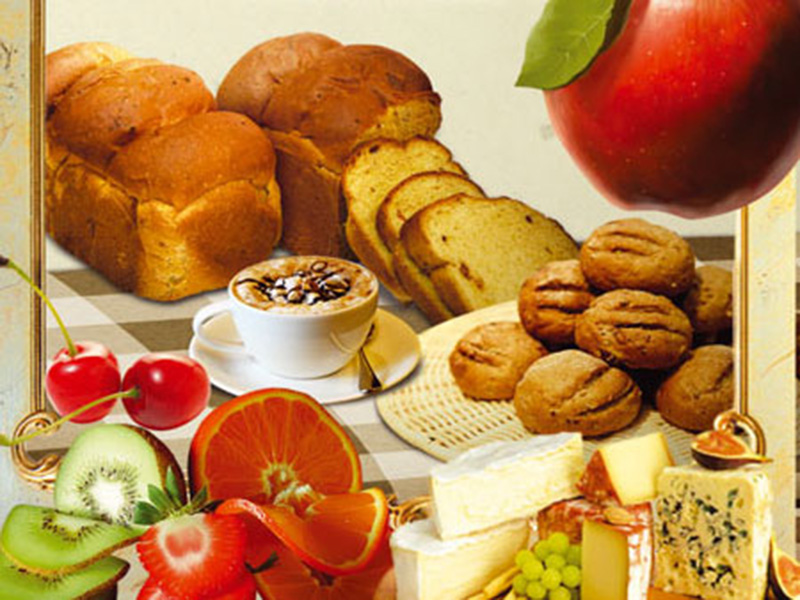 |
| "Thou causest the night to gain on the day, and thou causest the day to gain on the night; Thou bringest the Living out of the dead, and Thou bringest the dead out of the Living; and Thou givest sustenance to whom Thou pleasest, without measure." (Surat Al'Imran: 27) |
There is no doubt that for thinking, rational people, every taste is a means whereby to appreciate God properly, remember Him with gratitude, praise Him and give Him thanks.
Everybody knows that under normal conditions, even the most attractive-looking, delicious food soon spoils and becomes inedible. There is considerable wisdom behind this. One aspect of this is to remind us that the life of this world is merely transitory, and that it is a mistake to forget the Hereafter and become excessively attached to this life. Paradise is where the originals of the flavors in question persist throughout all eternity. This feature of Paradise is revealed in a verse:
An image of the Garden which is promised to those who guard against evil: in it there are rivers of water which will never spoil and rivers of milk whose taste will never change and rivers of wine, delightful to all who drink it, and rivers of honey of undiluted purity; in it they will have fruit of every kind and forgiveness from their Lord. Is that like those who will be in the Fire timelessly, for ever, with boiling water to drink which lacerates their bowels? (Surah Muhammad: 15)
 |
| ... eat what Allah hath provided for you, and follow not the footsteps of Satan: for he is to you and avowed enemy.(Suratal-An'am: 142) |
Some people do not know how to thank others enough for giving them food when they are hungry, entirely forgetting that our Lord gave them their splendid senses of smell and taste. The foods to be eaten by those who are ungrateful to God, Who has created countless blessings, are described thus in the Qur’an:
Hell, where they will roast. What an evil resting-place! This! So let them taste it—boiling water and scalding pus. (Surah Sâd: 56-57)
[The inhabitants of the Fire will be] drinking from a boiling spring. They have no food but a bitter thorny bush which neither nourishes nor satisfies. (Surat al-Ghashiyya: 5-7)
Footnotes
118. Diane Ackerman, A Natural History of the Senses, New York: Vintage Books, 1995, p.133. ![]()
119. Harold Mcgee, “Taking stock of new flavours,” Nature 400, 1 July 1999, pp.17-18. ![]()
120. Ayten Görgün, “Tek başına ne tadın ne kokunun anlamı var,”(Neither Taste nor Smell has Any Meaning Alone,) 2000, http://www.hurriyetim.com.tr/tatilpazar/turk/00/03/17/eklhab/08ekl.htm. ![]()
121. Selçuk Alsan, “Yemeklerin Tad›, Kokusu,” Bilim ve Teknik, (“The Taste and Smell of Food,” Science and Technology), February 1999, pp.98-99. ![]()
122. Eric Chudler, “That's Tasty,” 2001, http://faculty.washington.edu/chudler/tasty.html. ![]()
123. A.I. Spielman, J.G. Brand, and W. Yan, “Chemosensory Systems,” Encyclopedia of Life Sciences, June 2000, http://www.els.net. ![]()
124. Stuart J. Firestein, “Neurobiology: The good taste of genomics,” Nature 404, 6 April 2000, pp.552-553. ![]()
125. Charles Zuker, “A Matter of Taste,” HHMI Bulletin, June 1999, Vol. 12, no. 2, pp.10-13. ![]()
126. Stephen D. Roper, “Taste: Cellular Basis,” Encyclopedia of Life Sciences, May 1999, http://www.els.net. ![]()
127. A.I. Spielman, J.G. Brand, and W. Yan, “Chemosensory Systems,” Encyclopedia of Life Sciences, June 2000, http://www.els.net. ![]()
128. David V. Smith, Robert F. Margolskee, “Making Sense of Taste,” Scientific American, March 2001, pp.26-33. ![]()
130. The International Food Information Council Foundation, “Experiments in Good Taste,” Food Insight, March-April 1995, http://ificinfo.health.org/insight/exper.htm. ![]()
131. Stephen D. Roper, “Taste: Cellular Basis,” Encyclopedia of Life Sciences, May 1999, http://www.els.net. ![]()
132. A.I. Spielman, J.G. Brand, and W. Yan, “Chemosensory Systems,” Encyclopedia of Life Sciences, June 2000, http://www.els.net. ![]()
133. Stephen D. Roper, Op cit. ![]()
135. David V. Smith and Robert F. Margolskee, “Making Sense of Taste,” Scientific American, March 2001, pp.26-33. ![]()
136. Hiroaki Matsunami, Jean-Pierre Montmayeur, and Linda B. Buck, “A family of candidate taste receptors in human and mouse,” Nature 404, 6 April 2000, pp. 601-604; E. Adler, M.A. Hoon, K.L. Mueller, J. Chandrashekar, N.J. Ryba, and C.S. Zuker, “A novel family of mammalian taste receptors,” Cell 100, 17 March 2000, pp.693-702. ![]()
137. Linda B. Buck, “Search for Taste Receptors Yields Sweet Success,” Howard Hughes Medical Institute News, 6 April 2000; http://www.hhmi.org/news/buck2.html. ![]()
138. Charles S. Zuker, “A Matter of Taste,”HHMI Bulletin, June 1999, Vol. 12, no. 2, pp.10-13. ![]()
139. A.I. Spielman, J.G. Brand, and W. Yan, “Chemosensory Systems,” Encyclopedia of Life Sciences, June 2000, http://www.els.net. ![]()
140. “Brain (medicine),”.M. Encarta Encyclopedia 2001. ![]()
141. Eric Chudler, “Brain Facts and Figures,” 2001, http://faculty.washington.edu/chudler/facts.html. ![]()
142. A.I. Spielman, J.G. Brand, and W. Yan, “Chemosensory Systems,” Encyclopedia of Life Sciences, June 2000, http://www.els.net. ![]()
143. David V. Smith, Robert F. Margolskee, "Making Sense of Taste", Scientific American, March 2001, pp.26-33. ![]()
144. Tim Jacob, "Taste", 2001, http://www.cf.ac.uk/biosi/staff/jacob/teaching/sensory/taste.html. ![]()
145. A.I. Spielman, J.G. Brand, W. Yan, "Chemosensory Systems", Encyclopedia of Life Sciences, June 2000, http://www.els.net. ![]()
146. Charles Zuker, “A Matter of Taste,” HHMI Bulletin, June 1999, Vol. 12, no. 2, pp.10-13. ![]()
147. Diane Ackerman, A Natural History of the Senses, New York: Vintage Books, 1995, p.21. ![]()
149. Gina Smith, “High-Tech Taste Tests,” ABCNews, 1999; http://more.abcnews.go.com/sections/tech/cuttingedge/gina990304.html. ![]()
150. The International Food Information Council Foundation, “Taste Matters,” Food Insight, July-August 1999; http://ificinfo.health.org/insight/julaug99/tastematters.htm. ![]()
151. Milliyet Resimli Vücut ve Sağlık Ansiklopedisi İşte insan (Milliyet Body and Health Encyclopedia: The Human) Milliyet Publishing, p.13. ![]()
152. A.I. Spielman, J.G. Brand, and W. Yan, “Chemosensory Systems,” Encyclopedia of Life Sciences, June 2000, http://www.els.net. ![]()
153. Diane Ackerman, A Natural History of the Senses, New York: Vintage Books, 1995, p.139. ![]()
- Introduction
- The Creation in the Olfactory System
- Mechanisms within the System
- What Odors and the Olfactory System Suggest
- Animals' Sense of Smell
- Evolutionists Cannot Account for the Origin of the Sense of Smell
- Technology in the Olfactory System
- The Perfect Creation in the Taste System
- Conclusion
- The Deception of Evolution
